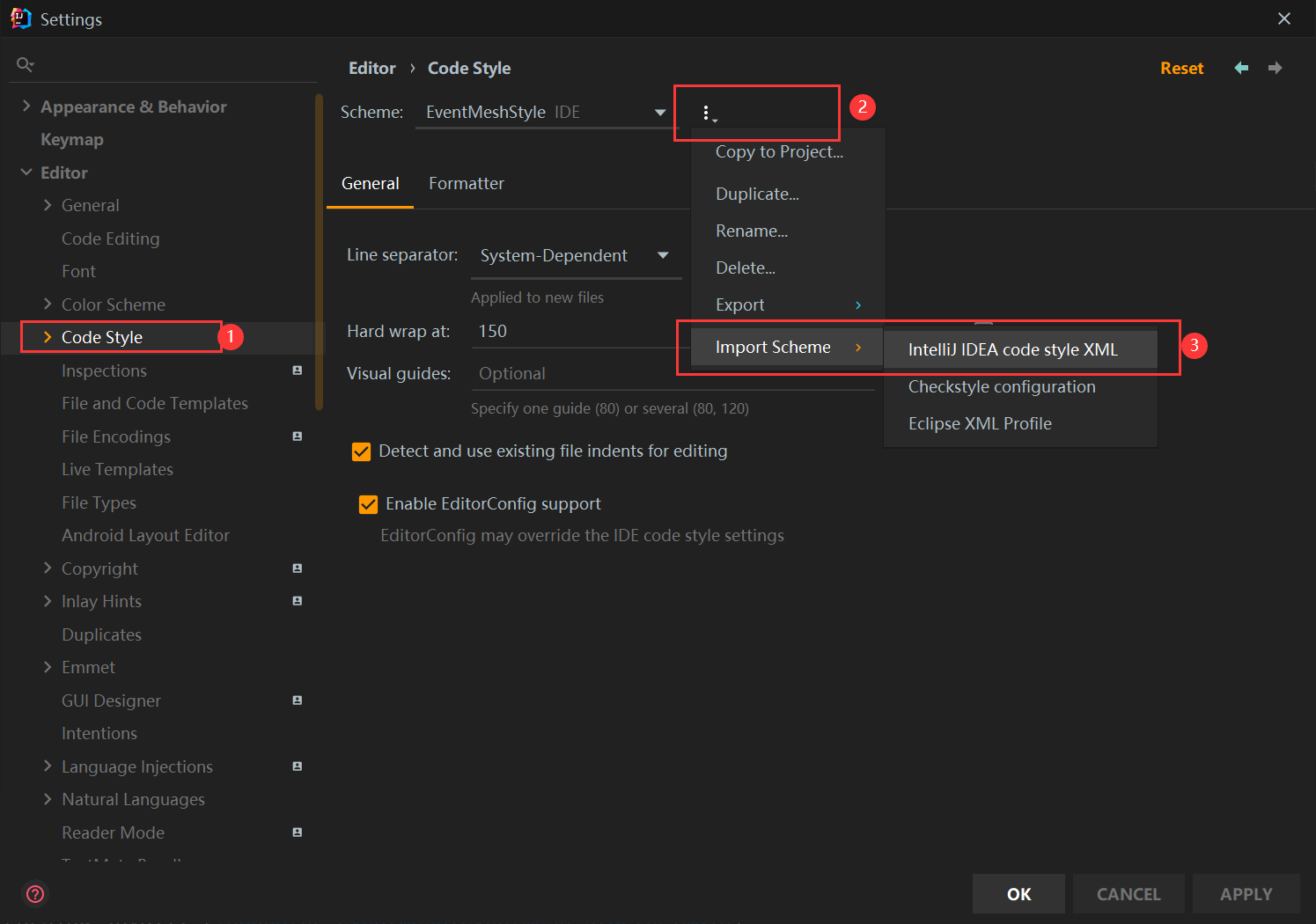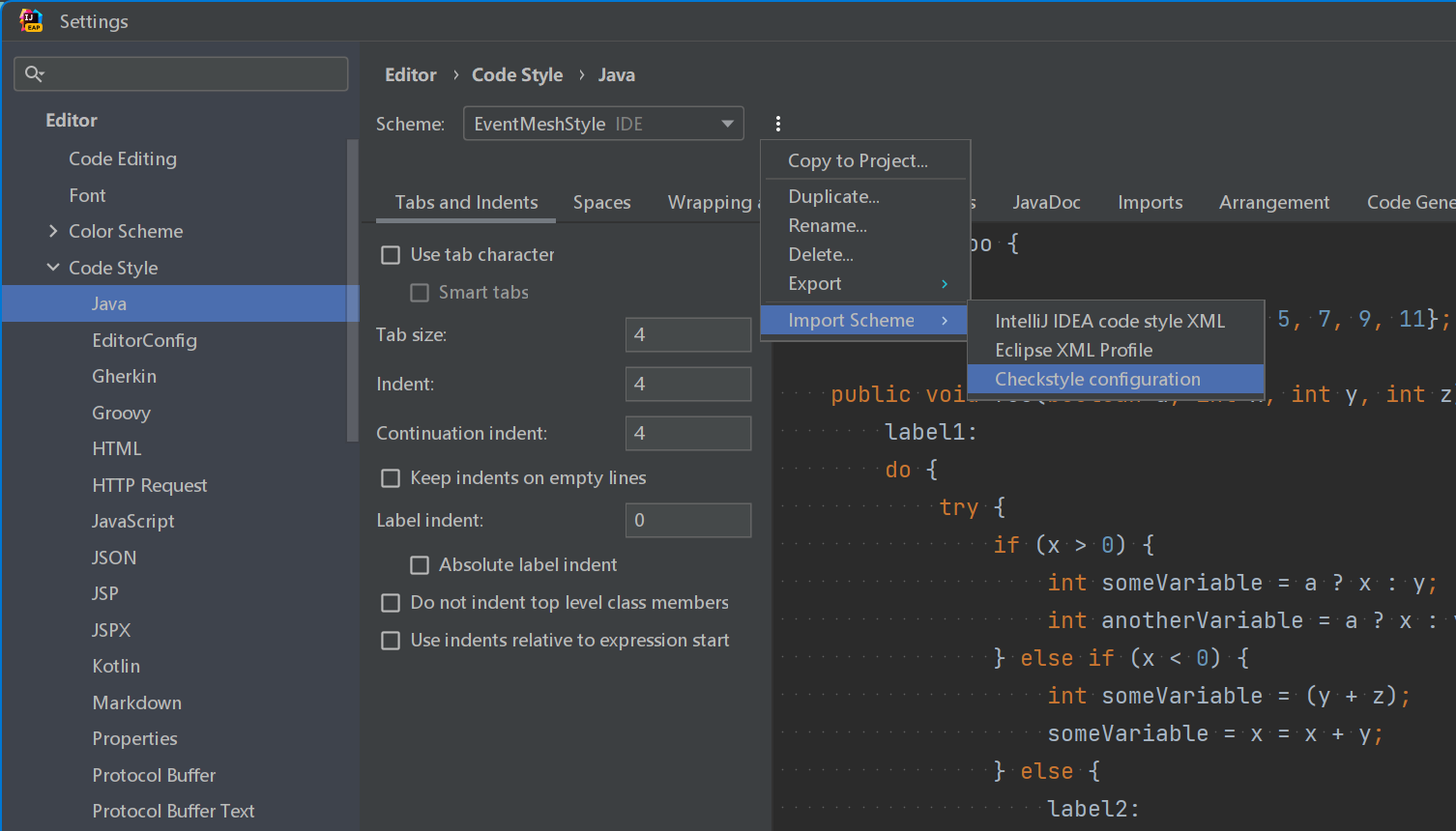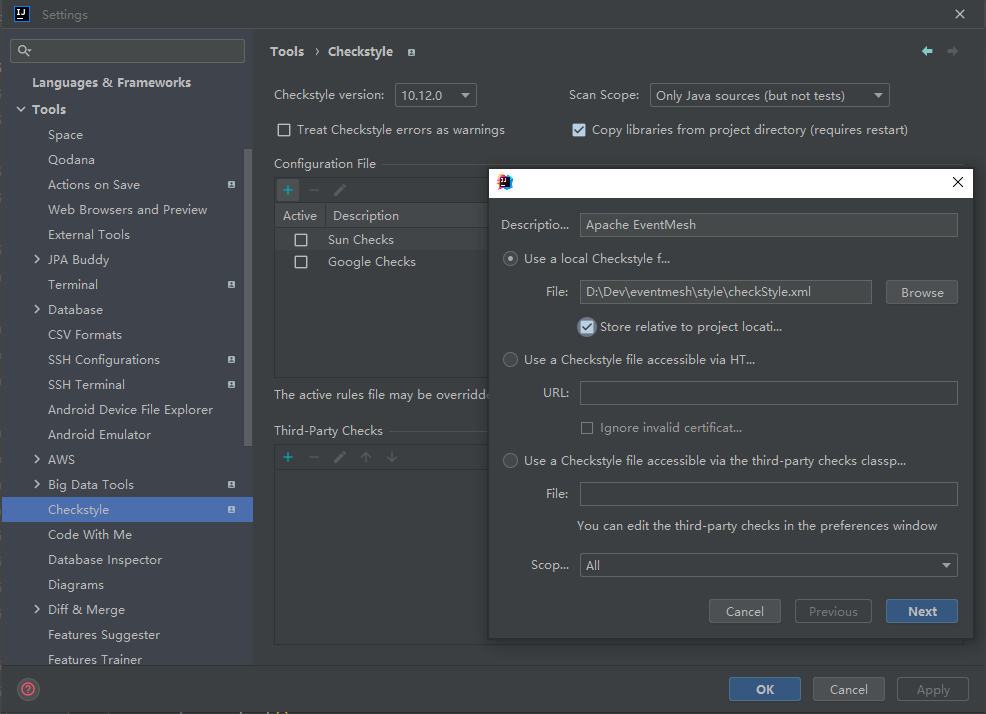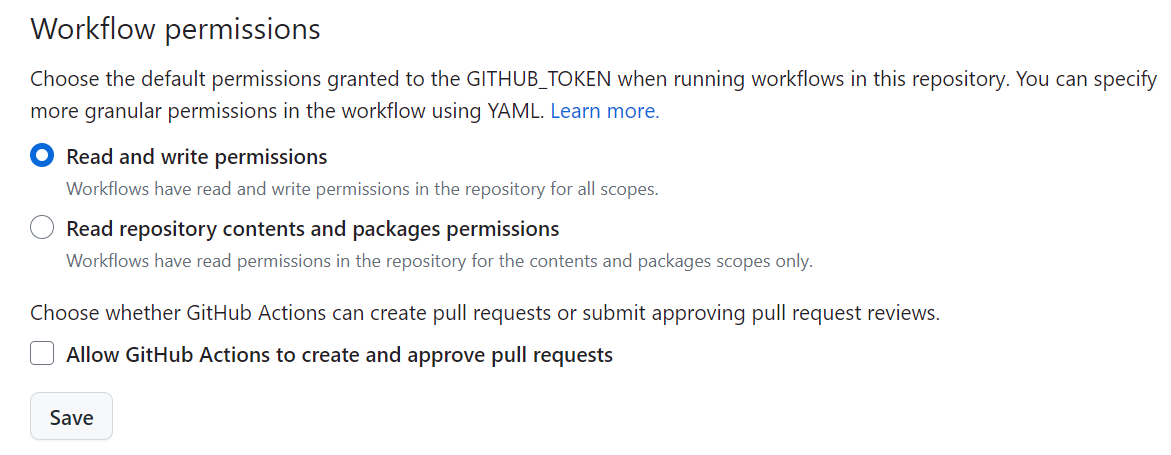How to Contribute
If you are a new contributor who wants to contribute to the EventMesh community, please read this document, which describes how to contribute to the community, and if you find any questions in the document, feel free to leave comments or suggestions.
Preparation
Development environment
- You should have the JDK installed in your development environment.
Code Style
Import Code Style
File location: Import the eventmesh-code-style.xml file located in the eventmesh/style directory of the source code into IntelliJ IDEA.
Settings -> Editor -> Code Style -> Import Scheme -> IntelliJ IDEA code style XML

Import CheckStyle
File location: Import the checkStyle.xmlfile located in the eventmesh/style directory of the source code into IntelliJ IDEA.
Please install the CheckStyle-IDEA plugin. For IDEA, you need to import the CheckStyle code style file in the following two settings:
Settings -> Editor -> Code Style -> Java -> Scheme -> Import Scheme -> CheckStyle Configuration
Settings -> Tools -> Checkstyle -> Configuration File


Enable CheckStyle
You can set EventMesh's code style file to Active (default option) in Tools -> Checkstyle -> Configuration File. Otherwise, before running CheckStyle checks, you will need to manually specify EventMesh's code style configuration.
Use CheckStyle Plugin
To check the code style of the current file, the simplest way is to right-click in the editor and execute Check Current File:

It will open a tab at the bottom where you can observe code style warnings output. If none appear, everything complies with the standards.

You can further run scans for the current module or the entire project on the left side of this tab.
(Note: When you submit a PR, the CI will only check the files that were changed in that PR).
Use CheckStyle Task
You can perform a code style scan for a specific module or the entire project in the right-side Gradle tab in IDEA:

You can also use ./gradlew check in the terminal to check the code style of all files in the project.
Continuous Integration
This configuration is not mandatory. You may enable GitHub Actions workflows in the Fork repository to promptly observe if new commits introduce compilation errors and reduce the waiting time for CI results after submitting a PR.
To do this, simply set Workflow Permissions to Read and write permissions at the following location:
Your Forked Repository -> Settings -> Actions -> General -> Workflow Permissions

Workflow
Here are the workflow for contributors:
Fork to your own
Clone fork to local repository
git clone git@github.com:yourgithub/eventmesh.git
- Create a new branch and work on it
git checkout -b fix_patch_xx
- Keep your branch in sync
git remote add upstream git@github.com:apache/eventmesh.git
git fetch upstream master:upstream_master
git rebase upstream_master
Commit your changes (make sure your commit message concise)
Push your commits to your forked repository
Create a pull request
Explanation
The original repository: https://github.com/apache/eventmesh Apache's EventMesh repository is called the original repository in this article.
The Forked repository: A fork from the original repository to your own personal repository is a fork repository.
So please fork the original EventMesh repository into your own repository.
Development branch
The current development branch of EventMesh is Master. Please submit PR to this branch.
- We recommend that you create a new branch in your repository for development and submit the branch to the master branch of EventMesh.
Contribution Categories
Bug feedback or bug fixes
- Whether it's a bug feedback or a fix, an issue needs to be created first to describe the bug in detail, so that the community can easily find and view the problem and code through the issue record. bug feedback issues usually need to contain a complete description of the bug information and reproducible scenarios.
Implementation of functions, refactoring
- If you plan to implement a new feature (or refactoring), be sure to communicate with the EventMesh core development team via an Issue or other means, and describe the new feature (or refactoring), mechanism and scenario in detail during the communication process.
Documentation Improvement
- You can find the EventMesh documentation at eventmesh-site, and the documentation is supplemented or improved in a way that is also essential for EventMesh.
Contribution method
There are two ways for new contributors to contribute to the EventMesh community:
If you find a bug in the EventMesh code that you want to fix, or if you provide a new feature for the EventMesh, submit an issue in the EventMesh and submit a PR to the EventMesh.
Other contributors in the EventMesh community have raised issues, the
issue for first-time contributorssorted out by the community here are relatively simple PR, which can help you familiarize yourself with the process of making contributions to the EventMesh community.
Submit issue guidelines
If you don't know how to raise an issue on EventMesh, please read about the issue.
In the EventMesh community, there are issue templates that can be used for reference, if the type matches please use the template, if the issue template does not meet your requirements, you can open an empty issue template, for the issue please bring its matching feature labels.
For the name of the issue, please briefly describe your question or purpose in one sentence, and write in English for better global communication.
Pull Request (PR) submission guidelines
If you don't know how to initiate a PR for EventMesh, please see about Pull Request.
Whether it's a bug fix, or a new feature development (if this PR is a new feature development, then documentation updates about the new feature should be included in this PR), please submit a PR to the current development branch master.
The PR submission should follow the template provided by EventMesh as well as the need to write the submission information, a brief description of what the PR you are submitting does is sufficient, please see the template for details.
The PR you submit needs to be associated with the issue you are fixing, or the issue you are raising,so your PR title should start with [ISSUE #xx].
If your change is about a typo or small optimize, you needn't create an Issue, just submit a PR and title with [MINOR].
Note:
A single Pull Request should not be too large. If heavy changes are required, it's better to separate the changes to a few individual PRs.
After creating a PR, one or more committers will help to review the Pull Request, after approve, this PR will be merged in to EventMesh repository, and the related Issue will be closed.
review
PR review
All code should be well reviewed by one or more committers. Some principles:
Readability: Important code should be well-documented. Comply with our code style.
Elegance: New functions, classes or components should be well-designed.
Testability: Important code should be well-tested (high unit test coverage).
License review
EventMesh follows Apache License 2.0 policy. All source files should have the Apache License header added to the file header. EventMesh uses the apache/skywalking-eyes to check the source file header.
PR merge
After a PR is approved by at least one committer, it can be merged. Before the merge, the committer can make changes to the commits message, requiring the commits message to be clear without duplication, and use Squash and Merge to make sure one PR should only contain one commits.
For large multi-person PR, use Merge to merge, and fix the commits by rebase before merging.
Community
Contact us
Mail: dev@eventmesh.apache.org